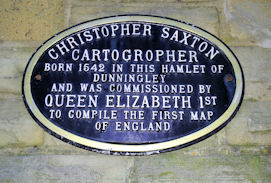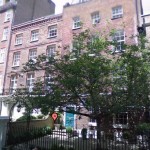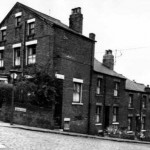Christopher Saxton – Dunningley
Extracted from The Registers of Topcliffe & Morley
Dunningley, within half-a-mile due east of Topcliffe, is noted as being the birthplace of Christopher Saxton, an eminent cartographer, and also as containing the residence of a sweetheart of Nevison, the highwayman. In Dr. John Dee’s Diary, 1596, appears this entry:- “July 10th, Manchester town described and measured by Mr Christopher Saxton.” Mr. J. E. Bailey, writes of this as follows :- “This Manchester survey which would be a valuable addition to out local topography, is not now known to be in existence. C. Saxton was the author of the first maps of Britain from actual survey. The series of maps was nine years in preparation and was first issued as a complete atlas of maps in 1579. Thoresby remarked that the maps had never been surpassed, scarcely equalled for exactness. Each map contains the arms of the Queen, who gave Saxton a patent for publishing the charts for ten years, and of Thomas Sackford, Master of Requests, who was employment, Saxton was at the date of the patent. Saxton was encouraged by Sir William Cordel, Master of the Rolls. His skill as a chorographer is set forth in his epitaph”. Thoresby says that in all probability he was buried in Batley Church.** Dunningley at the present time, consists of a few farm-houses, not remarkable for theit antiquity of picturesqueness.
** In Dugdale’s “Visitation of Yorkshire,”1666, “Birkbeck of Sheffield and Castleford” – Christopher Saxton, the geographer, here called Surveyor and Compiler of Maps of England, is said to have been of Dunningley. The Saxton’s were to be found at Mirfield, &c., a century afterwards.
Additional Saxton information – Saxton probably born c1540 in the parish of Dewsbury and grew up in the hamlet of Dunningley. He, as a young man, was in the employ of John Rudd the vicar of Dewsbury and Thornhill, a keen cartographer who passed his skills on to Christopher. In 1570 he started a commission from Lord Burghley to survey the whole of England and Wales. He died after 1610 as he is named in the will of his elder brother Thomas and before 1626 when the will of his son, Robert, was proved.
Wakefield – Its History and People says that Saxton was educated in one of the chantry schools within the town (Wakefield), before furthering his education at Oxford.
Much of Saxton’s work was used for many years and his atlas published in the late 1500’s was continually being re-issued and adapted until the late 1700’s. The issues were : William Hole and William Kip re-engraved Saxton’s maps and reduced them in size for the early 1600’s edition – Saxton being given credit for most of the map work. Later editions followed in 1607, 1610 and 16378. The Atlas – Atlas of the Counties of England & Wales is in the Special Collections Department of Glasgow University Library.
Christopher was granted arms and received lands from the crown, both showing how he was respected for his work. His grant of arms refers to him as “Christopher Saxton of Dunningly, gentleman”. But Wakefield has also laid claim to him.


